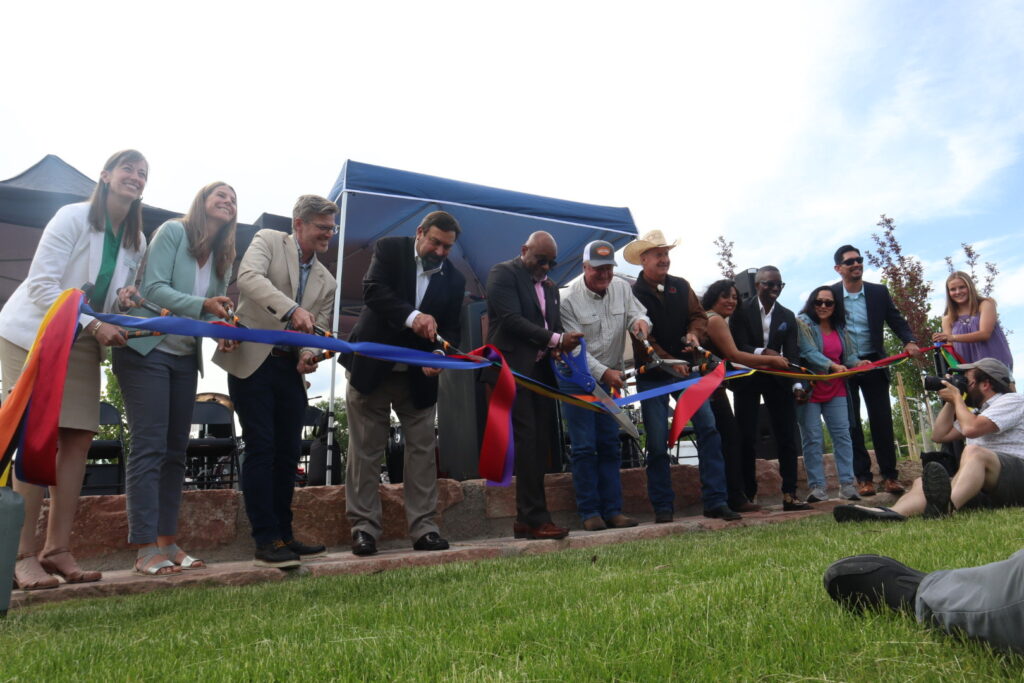By Gannon Rothman
Aportion of the South Platte River once covered by sewer pipes and railroad tracks is now open to outdoor recreation and education opportunities at the National Western Center in North Denver, following a massive restoration effort.
Officials who took part in the project, including Denver Mayor Michael Hancock, held a ribbon cutting recently to celebrate the official opening of the redeveloped 6-acre Riverfront Open Space. The space includes an outdoor amphitheater, trails and bike paths, and green spaces to host small community events.
“This space will serve as a reminder of what we can accomplish when we all come together with a shared purpose,” Hancock said to community members and visitors during the ceremony.
Colorado State University’s Spur campus also introduced the final phase of its new “Backyard,” which includes a water tank to collect rain water from the roof. That new space is joined with the recent Jan. 6 opening of the CSU Spur Hydro building, home to Denver Water’s new Water Quality Laboratory. This is where water experts will perform nearly 200,000 tests every year to ensure Denver’s water is at the highest quality.

The CSU Spur campus is open year-round for free to engage K-12 learners, with the riverfront being the new destination to provide a hands-on learning experience to better understand food, water, health and sustainability.
National Western Center Authority CEO Brad Buchanan joined the ribbon-cutting ceremony and explained how the Center is “creating something that doesn’t exist on the planet,” while thanking the partners involved, as well as the neighbors.
Community members are able to receive a 50% cost reduction for events held at the campus. Nonprofits can also receive help from the Center to assist with costs.
“(Before), you couldn’t ride a bike through here. This connects to the whole (South Platte River Trail) city and citywide system,” said Buchanan, who is also a former planning director for the city of Denver.
In 2015, the National Western Center Master Plan was laid out, backed by Denver voters, for the redevelopment and future vision of the National Western Complex and Denver Coliseum. Going back 15 years, the Stock Show and the city thought about how they could make the campus more active.
After the $100-million urban renewal construction project that started in 2018, the National Western Center is turning into a year-round destination that will introduce the future of food and agriculture, and Western culture and heritage in the middle of the Elyria-Swansea neighborhood.
“This project served a whole bunch of purposes. One that started working in this area in terms of cleanup, but also create this year-round home of the Stock Show, and then to implement this mission and vision of the National Western Center Master Plan,” Buchanan said. “Connecting education, entertainment and agriculture … we are evolving its relevance, this time with the voice of the community.”
While there are not many events lined up at the Center, there will be space for concerts, rodeos, and both large and small events that would be privately funded. Buchanan also noted that the project would have been impossible without residents from Globeville and Elyria-Swansea, some of whom were voting board members on the project.
“By creating a new riverfront open space that connects people to the natural environment and encourages activity and play, the National Western Center will become an anchor point that strengthens connections between Globeville and Elyria-Swansea, and will create a much-needed recreational amenity for North Denver residents,” Buchanan said.
In recent years, the GES Coalition has been looking into redevelopments within “the Triangle” of he National Western Center. Members of the group have called for the city and National Western Center Authority to put more than 45 acres of land at the National Western Center into the hands of the community to create affordable housing.
However, residents in the area did back the Riverfront Open Space and the Center’s project for redeveloping the land. Buchanan said that there’s still more work to be done and that “no one is giving up on each other.”
Recently, the Center kicked off community meetings on June 28 and 29, the first of several in which residents in the GES neighborhoods can share their input on future developments at the National Western Campus. Future developments within the Center’s Master Plan include building a bridge over the South Platte River that would eventually connect 48th Avenue to West River Drive.
“Now it’s about how we program it, that’s what we’re trying to do now,” Buchanan said. “How do we bring the campus to life in ways that are relevant and authentic and important to the community.”

“ the National Western Center is turning into a year-round destination that will introduce the future of food and agriculture, and Western culture and heritage in the middle of the Elyria-Swansea neighborhood.”
In the middle of a neighborhood that is a food desert!! As a resident of GES I’m offended and insulted every time the National Western uses the above words no acknowledgment of the fact that the residents have to travel 20 to 30 minutes outside of GES to get to the grocery store
National Western has stated that they will provide affordable or free farmers market items to the GES community that’ll only be during harvest time. the community will still have to travel outside of the community to just buy basic necessities and also to continue to buy fruits and vegetables are part of harvest season